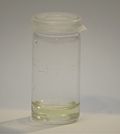nomenclature, a preferred IUPAC name (PIN) is a unique name, assigned to a chemical substance and preferred among all possible names generated by IUPAC nomenclature...
10 KB (1,152 words) - 01:24, 6 July 2025
Chemical nomenclature (redirect from IUPAC chemical nomenclature)
systematic IUPAC name. However, some compounds may have alternative names that are also accepted, known as the preferred IUPAC name which is generally...
26 KB (3,077 words) - 15:37, 1 May 2025
(preferred IUPAC name: 2-methylpropyl) If it connects at the central carbon, it is tertiary butyl, tert-butyl or t-butyl: −C(CH3)3 (preferred IUPAC name:...
10 KB (977 words) - 17:50, 28 July 2025
In chemical nomenclature, the IUPAC nomenclature of organic chemistry is a method of naming organic chemical compounds as recommended by the International...
40 KB (4,524 words) - 19:49, 7 July 2025
named by reference to pyran, which contains two double bonds, and may be produced from it by adding four hydrogens. In 2013, its preferred IUPAC name...
8 KB (690 words) - 03:42, 12 December 2024
only name in the class of ethers which is retained both as a preferred IUPAC name and for use in general nomenclature. For preferred IUPAC names, no substitution...
9 KB (809 words) - 17:45, 6 November 2024
as TNT (and more specifically 2,4,6-trinitrotoluene, and by its preferred IUPAC name 2-methyl-1,3,5-trinitrobenzene), is a chemical compound with the...
39 KB (4,205 words) - 00:11, 25 June 2025
Tricaprin Names Preferred IUPAC name 2,3-di(decanoyloxy)propyl decanoate Other names Tridecanoin; Glyceryl tricaprate Identifiers CAS Number 621-71-6 Y...
8 KB (699 words) - 07:36, 19 July 2025
Parent structure (redirect from Parent name (chemistry))
ISBN 978-0-471-72091-1 Preferred IUPAC Names Provisional Recommendation september 2004 Chapter 1 Par. P-12.1 Preferred IUPAC Names Provisional Recommendation...
4 KB (381 words) - 20:51, 12 February 2023
Sulfuric acid (category CS1 maint: multiple names: authors list)
Sulfuric acid (American spelling and the preferred IUPAC name) or sulphuric acid (Commonwealth spelling), known in antiquity as oil of vitriol, is a mineral...
65 KB (7,178 words) - 21:14, 20 July 2025
2-Imidazoline (Preferred IUPAC name: 4,5-dihydro-1H-imidazole) is one of three isomers of the nitrogen-containing heterocycle imidazoline, with the formula...
10 KB (901 words) - 07:25, 24 May 2025
IUPAC nomenclature is a set of recommendations for naming chemical compounds and for describing chemistry and biochemistry in general. The International...
12 KB (1,470 words) - 10:18, 19 July 2025
other common names, often originating in historical source material thereof. The systematic IUPAC name is not always the preferred IUPAC name, for example...
22 KB (89 words) - 14:18, 10 July 2025
Methylene (compound) (category CS1 maint: multiple names: authors list)
reactions. The trivial name carbene is the preferred IUPAC name. The systematic names methylidene and dihydridocarbon, valid IUPAC names, are constructed according...
16 KB (1,674 words) - 16:55, 26 March 2025
SLU-PP-332 Names Preferred IUPAC name 4-Hydroxy-N-[(Z)-naphthalen-2-ylmethylideneamino]benzamide Other names SLU-PP-332 Identifiers CAS Number 303760-60-3...
4 KB (265 words) - 18:52, 4 July 2025
the retained name 'urea', which is the preferred IUPAC name, with locants N and N′, as shown above the structure below. The systematic name is 'carbonic...
62 KB (7,093 words) - 01:36, 19 July 2025
ISBN 978-0-85404-182-4. Aniline, for C6H5-NH2, is the only name for a primary amine retained as a preferred IUPAC name for which full substitution is permitted on the...
39 KB (4,129 words) - 22:52, 27 July 2025
represent sulfur. For example, SO 2 is sulfur dioxide. Used in the preferred IUPAC name for a chemical to indicate a specific enantiomer. For example,...
23 KB (2,075 words) - 19:15, 12 July 2025
Catechol (category CS1 maint: multiple names: authors list)
the officially "preferred IUPAC name" (PIN) of catechol is benzene-1,2-diol. The trivial name pyrocatechol is a retained IUPAC name, according to the...
22 KB (2,127 words) - 16:53, 3 June 2025
2,6-Dichlorobenzonitrile Names Preferred IUPAC name 2,6-Dichlorobenzonitrile Other names Dichlobanil, Dichlobenil Identifiers CAS Number 1194-65-6 Y 3D...
10 KB (870 words) - 16:07, 16 July 2025
Thiirane Names Preferred IUPAC name Thiirane Systematic IUPAC name Thiacyclopropane Other names 2,3-Dihydrothiirene Ethylene sulfide Identifiers CAS Number...
6 KB (357 words) - 05:11, 2 June 2025
Nile red Names Preferred IUPAC name 9-(Diethylamino)-5H-benzo[a]phenoxazin-5-one Other names Nile red, Nile blue oxazone Identifiers CAS Number 7385-67-3 Y...
8 KB (740 words) - 01:16, 27 February 2025
ISBN 978-0-85404-182-4. The retained names adamantane and cubane are used in general nomenclature and as preferred IUPAC names. "Start". Biegasiewicz, Kyle;...
22 KB (1,951 words) - 15:09, 24 July 2025
chemistry, in the conception of materials and molecular devices. The preferred IUPAC name of the base compound, barbituric acid, is 1,3-diazinane-2,4,6-trione...
44 KB (4,716 words) - 21:25, 15 July 2025
of the presence of two suffixes; it is not an alternative to the preferred IUPAC name, '2-aminoethan-1-ol'. "Ethanolamine MSDS" (PDF). Acros Organics....
17 KB (1,548 words) - 07:13, 8 June 2025
plants as caraway, dill, and bergamot orange plants. Limonene takes its name from Italian limone ("lemon"). Limonene is a chiral molecule, and biological...
19 KB (1,542 words) - 06:24, 12 July 2025
Sulfur (American spelling and the preferred IUPAC name) or sulphur (Commonwealth spelling) is a chemical element; it has symbol S and atomic number 16...
97 KB (10,794 words) - 20:18, 30 July 2025
DEET (category CS1 maint: multiple names: authors list)
DEET and icaridin in field studies and concluded that they are equally preferred mosquito repellents, noting that 50% DEET offers longer protection but...
34 KB (3,376 words) - 19:41, 27 July 2025
Triphenylamine Names Preferred IUPAC name N,N-Diphenylaniline Other names Triphenylamine N,N,N-Triphenylamine N,N-Diphenylbenzeneamine Identifiers CAS...
5 KB (438 words) - 21:51, 10 April 2025
for better adhesion. Nomenclature of Organic Chemistry: IUPAC Recommendations and Preferred Names 2013 (Blue Book). Cambridge: The Royal Society of Chemistry...
6 KB (358 words) - 23:19, 3 February 2025




















